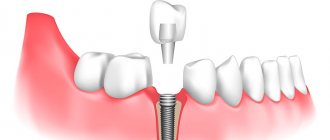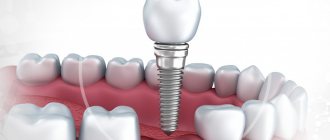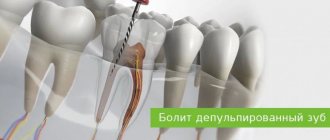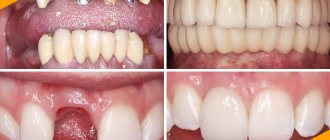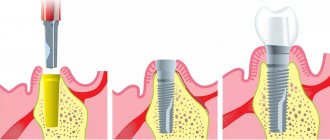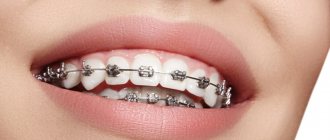Content:
- Conditions that must be met
- Do I need to install new dentures before fixing braces?
- Preparing to install braces
- Installing braces on teeth
- Risks and complications you may encounter
Since correction of malocclusions is most often carried out in adolescence and young adulthood, most patients in dental clinics do not even think about whether it is possible to put braces on crowns?
This question is relevant for older people who decided to make their appearance more attractive even when they were faced with partial edentia. It is possible to place braces on permanent crowns, but certain conditions must be met for this to happen. Therefore, before planning the installation of braces, you should consult your doctor. He will conduct an examination and tell you what can be done to improve the aesthetics of your smile in a particular situation.
Will the crowns become an obstacle?
Dentures installed after the destruction of living teeth do not resist the use of braces. However, if they are present in this case, you need to take into account some nuances.
In order not to damage the bridge-like prosthesis placed on the support crowns, it is either removed, replacing it with a temporary one, or sawed to avoid damage to the structure as a whole.
It is better to install metal leveling structures on crowns. After all, the adhesion of metal to an artificial surface is much higher.
Important to know: It is also important not to put stress on artificial teeth when wearing braces, and not to use hard foods, chewing gum or taffy.
Conditions that must be met
The main requirement, subject to which it is possible to install braces on dentures, is that the roots of the teeth must be “living”. If they are not, due to the pressure exerted by the corrective system, the tooth may become loose and then fall out altogether.
It is also important to remember that the arc will give one long and strong. This can cause a change in the shape of the coronal part, that is, make it unaesthetic and curved. After removal of the orthodontic apparatus, most likely, the artificial dental structure will no longer be able to restore its previous shape. Thus, it may be necessary to manufacture a replacement. And this is troublesome and expensive.
If there is an element made of plastic, then it is strictly forbidden to stick braces on it. This material is very tiny. He is not able to withstand pronounced pressure from the outside. The breakdown of the plastic element will happen faster than the braces have time to somehow affect the curvature of the dentition. This means that treatment will have to start from the very beginning.
Care instructions
Without proper care of braces and crowns, problems are unlikely to be avoided. Treatment is impossible without observing a number of important rules, which the attending dentist will definitely tell you about before sending your patient home. It is extremely important to brush your teeth daily, morning and evening, and after all meals and sugary drinks.
To maintain hygiene, both classic brushes with bristles of different hardness, as well as single-tuft options and brushes are perfect. You should also purchase a suitable rinse aid to treat the cavity after cleaning. It will not only remove food particles from hard-to-reach places, but also freshen your breath.
A device such as an irrigator has proven itself to be excellent. Additionally, you can purchase dental floss and therapeutic and prophylactic pastes. Braces need to be cleaned from all sides, paying attention to the areas under the clasps and archwire.
previous post
Why get braces?
next entry
Do I need to install new dentures before fixing braces?
There is no need to do anything with the existing systems before orthopedic treatment.
They must remain in their places. There is no point in replacing them with new ones, since, as noted above, they can become deformed due to arc pressure. But no one can rule out the fact that new crowns will have to be made after straightening the dentition. There is one “but” here. If there are elements in the mouth that are loose, cause pain, or do not adhere well to the dental stump, then, of course, it is not recommended to fix braces on their surface. In these situations, replacement of low-quality crowns is mandatory.
Some patients want their crowns removed and replaced with cheaper temporary alternatives during treatment. In principle, this is possible, but not always advisable. Once your braces are removed, many units will change their position. No one can give a guarantee that the removed elements will be able to “sit” tightly in their original places. Then we will definitely have to make new designs.
It is important to understand that the success and safety of installing braces on artificial supports largely depends on the qualifications and experience of the doctor who conducts orthodontic treatment. You should not trust your oral health to specialists whose professionalism is questionable. At the Line of Smile dental clinic, we see orthodontists who know how to straighten teeth, even if you already have several crowns in your mouth. Feel free to contact them.
Crown classification
There are different types of artificial crowns. According to their purpose, they are divided into support-type products (used as supports for bridges) and restoration ones.
Regarding the material of manufacture, crowns are divided into:
- combined;
- metal products.
According to the manufacturing method, crowns are distinguished:
- cast;
- stamped.
About a decade ago, metal overlay products were in great demand. Outwardly, they looked like an artificial metal tooth. They made both cast and stamped metal structures.
Cast products are made based on impressions of the patient's dentition. The most common material used is a nickel-cobalt alloy. Cases of using titanium, palladium and silver are also not uncommon.
If desired by the client, the product can be coated with gold plating. But it is advisable to install such dentures on chewing teeth that are not in the smile zone. Crowns are used in cases where there is no need for immediate tooth extraction, but it will not be able to function on its own, and an onlay will prolong its life.
Stamped crowns are cheaper than cast crowns and are placed on the remaining part of the tooth, which does not need to be removed.
Recently, customer preference has been given to prostheses that do not contain metal. These include:
- ceramic;
- porcelain;
- plastic.
Ceramic products can be selected according to color and transparency relative to tooth enamel with great precision. The framework for ceramics is usually zirconium oxide. These crowns come with a fifteen-year warranty.
Porcelain structures last less. But externally they are as aesthetically pleasing as possible. They are not used as fastenings for bridges. Such designs are quite expensive.
Plastic products are often installed as temporary ones during the manufacture of the main prosthesis. And also if it is necessary to install a bracket system on the crowns. Outwardly, they repeat all the characteristics of living teeth, but their service life is short - approximately 12 months.
Combination products combine a metal inner base with a plastic, composite, porcelain or ceramic shell.
Advantages of combined products:
- no need to remove the dental nerve;
- You can make an entire bridge from crowns.
Metal-ceramic products are very widespread today. They are very durable and last a long time. Aesthetically they are also excellent. The disadvantage of such products is the possible darkening of the gums, where it is adjacent to the metal base of the crown.
Preparing to install braces
Before gluing the leveling system, all existing dental diseases are treated. It is necessary to treat all carious cavities, pulpitis, and replace damaged dentures.
If an infection is diagnosed, anti-inflammatory therapy is carried out. It is forbidden to work with an incorrect bite until the pathology enters the “dormant” phase.
All teeth must be cleaned of plaque and tartar. For this purpose, the dental hygienist uses an ultrasonic scaler. It “knocks off” particles from the enamel and makes the tooth surface as smooth and clean as possible.
Installing braces on teeth
Fixation of the orthodontic apparatus if the patient has crowns in the mouth is carried out according to the traditional scheme:
- Dental surfaces are thoroughly cleaned and dried.
- The enamel and surface of the prosthesis are etched with a special dental composition. Due to this they become more porous. This is necessary for strong adhesion of surfaces. If necessary, a certain area of the crown to which the clasp will be glued can be treated with a drill. Again, to make it rougher.
- Then cement is applied and locks are glued. Excess glue is removed and polymerization is carried out. As a result, the adhesive composition hardens.
- The final procedure is to thread a pressure arc through the braces. If we are talking about a ligature system, then various wires and elastic bands are used for fixation. In the case of self-ligating devices, the arc is simply snapped into place with locks located on the plates.
When installing braces on crown supports, the orthodontist must very competently assess the progress of the upcoming correction and predict all possible problems. The fact is that the tooth and the “cap” covering it are not a solid element - they are separated by a layer of cement.
If the pressure applied to the top is too strong, it may unravel, but the pin inside it may remain intact. It also happens that the upper element, on the contrary, remains motionless, and the remains of the tooth covered with it begin to rotate. It is very important that the turn touches the entire structure.
Risks and complications you may encounter
If the orthotic system is attached to a prosthesis, there are certain risks. This means:
- An artificial element can suffer significant mechanical damage. Then you will have to replace it.
- Only the crown can unfold, but the root itself will remain in its original position.
- The pressure of the arc can cause unsightly chips on an expensive crown. You will have to put up with them.
- If the roots are dead, they may break. This is a very serious complication. Then you will need to remove braces, remove the prosthesis, and pull out the roots. After healing, it will be possible to carry out implantation or think about making a dental bridge.
- Slight change in facial symmetry. This is possible due to incorrect displacement of the roots located under the dentures.
- Unaesthetic appearance of the crown after removing braces. While natural enamel can regenerate, artificial materials cannot.
Considering the possible problems, the orthodontist must weigh the pros and cons and give his verdict to the patient. If the doctor says that orthodontic therapy is undesirable, then it is better to listen to his words. If, after an in-person examination and diagnostic procedures, the doctor concludes that the bite correction should take place without significant complications, then you can safely begin the alignment.
Operating principle
To correct the bite, structures made of various materials (metal alloys, ceramics, etc.) are used. The metal wires apply even pressure on the teeth, causing them to snap into place. The metal triggers activity at normal basal temperature, and the pressure on each tooth is calculated by the orthodontist.
In this case, the pressure is not applied to the tooth itself, but to a certain area glued to its surface using special glue. The platform can be made of various materials. In this case, it means pressure on intact teeth (not subject to correction).

